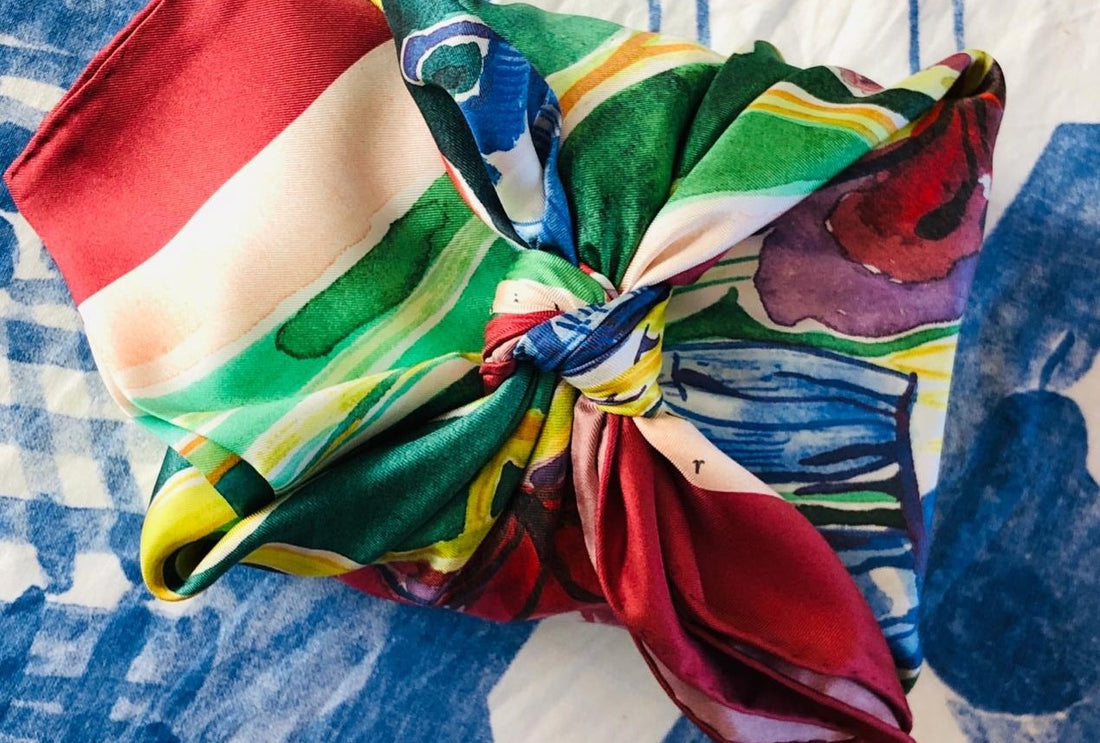
Furoshiki - The Art of Wrapping
Furoshiki (風呂敷) are a type of traditional Japanese wrapping cloth traditionally used to transport clothes, gifts, or other goods and embrace the philosophy of eco-friendly living. It is a beautiful and ingenious art which allows one object to have many uses simply by folding and tying the cloth in a different way. When it comes to gift-wrapping furoshiki is the perfect way to convey thoughtfulness and courtesy through the care taken in the choice of wrapping and in the way the fabric is folded and tied.

An old - new artform of wrapping
Cloth wrapping has been used for over 1200 years in Japan and the word furoshiki came about during the Edo period (1603-1868) when the cloths were commonly used in bath houses to wrap clothes and as bath mats to avoid mixing them up. The word furoshiki means 'bath spread'.
When plastic bags began being used in Japan, furoshiki use declined substantially. A resurgence in the artform has occurred recently as environmental awareness is increasing and many modern furoshiki are designed with contemporary fabrics seeking to appeal to younger generations.
Versatility
Whereas regular bags have a fixed amount of space that can only carry a particular type of object, a furoshiki is highly versatile and can be adapted to suit the exact needs of the specific objects to be carried.
Traditionally both the colour and the printed design on the furoshiki is meaningful, so it's important to choose the correct cloth for the occasion. The giver presents the receiver with the gift, unveils it then keeps the cloth for the next use.
While Japanese culture is not alone in using fabric wrapping, furoshiki has a distinctive style reflecting their interest in ceremony, beauty, multi-functional objects and thoughtful detail in their approach to everyday living.

Over time, they developed a multitude of uses and patterns that are both elegant and functional. One furoshiki cloth can be used for:
- wrapping a gift
- a bag for shopping
- decorating a handbag
- a picnic hamper
- a tablecloth
- household decor
- a scarf, belt or bandana
- wrapping clothes when travelling
Eco-friendly wrapping
Western culture is beginning to pick up on furoshiki and you will discover that it's easy to wrap your own gifts. It's even quicker than paper wrapping!
Including some instructions on how to tie a furoshiki as part of your gift is a nice touch, and it's also helpful to give the person a demonstration to show them just how simple it is. This ensures your furoshiki has a high chance of being passed on and spreading the eco-friendly fabric wrapping message on its' journey.
Modern furoshiki can be made of a variety of cloths, including silk, chirimen, cotton, rayon, and nylon. Furoshiki are often decorated with traditional designs or by shibori.
Of course a silk scarf is the most beautiful way to wrap a present. Your silk scarf makes the present really precious. You will get to keep your scarf but you will make the recipient feel extra special and you are also acting environmentally conscious.
Here are some other affordable and eco-friendly ideas for acquiring or making your furoshiki cloths:
- scarves in various fabrics
- fabric samples
- decorated or painted cut up old sheets
- over-cuts
- a bandana, handkerchief or tea towel

There is no one set size for furoshiki, they can range from hand sized to larger than bed-sheets. The most common sizes are 45 cm (17.7 inch) and 68–72 cm (26.7-28.3 inch). For wrapping, the object should be approximately one-third of the furoshiki's diagonal line and there are some traditional sizes that tend to work well for a range of objects.
50 cm - small book
70 cm - T-shirt
90 cm - a bottle of wine

Furoshiki in the world today
In 2006, the Japanese Minister of the Environment, Yuriko Koike, created a furoshiki cloth to promote its use in the modern world. A research group in Argentina promotes the use of furoshiki through the investigation of techniques and ways to adapt to Argentine customs.
In 2010 in Venezuela, ethical brand led by Maki Caballero de Criscaut created the project EcoSchool / ECOlegio. An environmentally conscious program educating kids kindergarten and up, about their impact in the World. Specifically the impact of the use of plastic bags. Promoting the Furoshiki as the ultimate reusable bag.
View a quick demonstration here:
References:
https://www.1millionwomen.com.au/blog/how-furoshiki-fabric-wrapping/
https://en.wikipedia.org/wiki/Furoshiki

